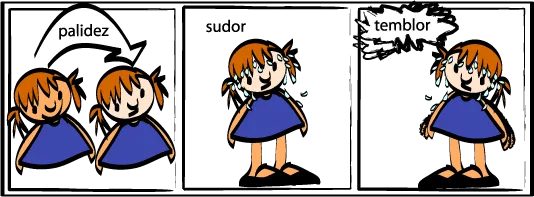Hypoglycemia means "low blood sugar/glycemia."It is currently considered that a person has hypoglycemia when their blood sugar level is less than 70 mg/dl.A few years ago hypoglycemia was defined below 54 mg/dl, but it has been evidenceredefinition of hypoglycemia.
Why do some people notice hypoglycemia with higher values than others?
This is due to "glucostate."The blood sugar level in which hypoglycemia is perceived will function as a thermostat.This thermostat or glucostate will be activated to a certain level of blood glucose.The level will depend on how glycemia has been the previous days.Thus in a person whose sugar levels have very high state, the glucostate will be activated and the symptoms of hypoglycemia will appear with a glucose level higher than normal.However, in a person with frequent hypoglycemia, this "glucostate" will be activated with blood glucose levels lower than normal, which can lead to what is called inadvertent hypoglycemia that are more dangerous.
It is also important to remember that children will notice hypoglycemia later if they are playing or if they are very focused on something.
Causes of hypoglycemia
Hypoglycemia is the acute complication of the most frequent diabetes.I could appear in many circumstances:
- Excessive insulin dose.
- Insufficient carbohydrates at meals.
- Delayed meals in time.
- Extra exercise for the dose of insulin administered.
- Some oral antidiabetics can also cause hypoglycemia.
- Muscle insulin administration instead of subcutaneous tissue.
- Errors in insulin administration (administer rapid insulin instead of delayed, or dose errors)
- Bath or shower with water very hot shortly after the insulin has been punctured.
- Hypoglycemia symptoms
Hypoglycemia symptoms are divided into two groups.Those originated in the brain as a result of the lack of sugar (neuroglucopenic symptoms), since the nervous system suffers greatly due to the lack of glucose, and those related to the attempts of the body to maintain normal glucose levels (adrenergic symptoms).
The first to occur are adrenergic symptoms since they are a consequence of the secretion of counter -regulatory hormones (hormones that oppose the action of insulin) and that are secreted to be able to counteract hypoglycemia.Subsequently, the symptoms caused by the glucose deficit in the brain (neuroglucopenic symptoms) will occur.
Adrenergic symptoms:
- Palencia
- Cold sweat
- Irritability
- Hunger
- Shaking
- Nausea
- Palpitations
- Anxiety
Neuroglucopenic symptoms:
- Lack of concentration
- Confusion
- Dizziness and weakness
- Headache
- Double or blurred vision
- Heat or cold sensation
- behavior alteration
- Long -term memory alteration
- Unstable march, lack of coordination
- Lapsus of consciousness
- Seizures
Night hypoglycemia
Hypoglycemia are also produced during the night.These are more frequent than it is believed, so it is advisable to usually do night controls.With the symptoms of a night hypoglycemia, one can wake up or not, it depends on the sleep phase during which it occurs.The guiding symptoms of nightly hypoglycemia are:
- Nightmares
- Sweating (getting up with wet sheets)
- Wake up with a headache or "stunned"
-Walk sleepwalking
- Tiredness when getting up
- Wake up with increased heart rate.
- Types of hypoglycemia
mild
That one that one can treat for himself and glycemia goes back easily.
moderate
It is possible to treat yourself.In this case, the body reacts producing regional symptoms that allow the appropriate decisions to be made.
Inadverted
Neuroglucopenic symptoms occur without adrenergic warning symptoms.If a diabetic has many hypoglycemia, the counter -regulatory hormones will be secreted increasingly at lower levels of blood glucose, which will lead to the symptoms of glucose deficit in the brain without having noticed warning symptoms.
severe
The symptoms are so severe that they make the person unable to react.A second person is required to help trace hypoglycemia by administering oral glucose or glucagon.Loss of consciousness and seizures can occur.
delayed
It is a term that is used to define those hypoglycemia that occur between 4 and 24 hours after having done physical exercise.This is because during the year the liver glycogen reserve has been used.This reserve tends to “fill” after exercise which could cause hypoglycemia.
How can hypoglycemia be prevented?
It is very important to prevent hypoglycemia, in this way we will maintain our body's ability to react to them intact.Here is a series of tips:
- Make a greater number of controls during the day, especially if physical exercise has been done.
- Plan in advance the physical exercise to be carried out to be able to adjust the insulin to be administered and the carbohydrates that will be eaten.
- Do control before bedtime and drink carbohydrates if necessary.
- Never puncture insulin without glymia control.
- Adjust hyperglycemia corrections as much as possible to avoid subsequent hypoglycemia.
- Take into account the insulin injection site, since there are areas where insulin is absorbed faster than in others.
- When clicking the insulin in an area with little subcutaneous fat, take a pinch, in this way we will avoid injecting on muscle that would favor an absorption of insulin much faster.
- Do not drink alcohol, but if we do we will have to eat rations of slow absorption carbohydrates and make more controls during the night.
- Hypoglycemia treatment
It is very important to prevent hypoglycemia, in this way we will maintain our body's ability to react to them intact.Here is a series of tips:
First, it must be confirmed that it is indeed hypoglycemia performing control.We cannot trust only what we notice, because there are times when, despite having hypoglycemia symptoms, we have no hypoglycemia.This is called "false hypoglycemia" and occurs when glucose levels fall very quickly.If the symptoms do not allow us to perform control, we must take some sugar immediately.
Once the hypoglycemia is done and proven, we will take rapid absorption carbohydrates (glucosport, sugar, fruit juice, sugary soft drinks).The amount to be taken will vary depending on age and glucose level.Normally between 5 and 15 gr of carbohydrates will be taken.
The right thing is to make a glucose measurement at 15 minutes and check that hypoglycemia is tracing.If it has not been traced, the administration of rapid absorption carbohydrates must be repeated.
If the figures ofGlycemia should be taken carbohydrates slow absorption (cookie, bread, yogurt ...).The amount to be taken will be between 5 and 15 gr of carbohydrates.
No physical exercise should be performed until all hypoglycemia symptoms have disappeared.
A child should not be left only when he has a hypoglycemia (he should not leave class to go to the infirmary, the hypoglycemia sitting at his class table) must be treated.
Once the hypoglycemia is resolved, we must write it down in our diabetes booklet and think why we have had a "drop."
If we are facing severe hypoglycemia:
- If the person is unconscious, it is dangerous to give carbohydrates by mouth, so that at this time he would be - to administer intramuscular or subcutaneous glucagon.
- Perform glycemia control as soon as possible.
- Once the conscience has been recovered in about 10 or 15 minutes, the phases of hypoglycemia treatment that have been explained previously must be applied.
- All children with diabetes must have glucagon ampoules at home, at school and in those places where they are at risk of hypoglycemia.It is important to review the expiration date of the ampoules from time to time.
The glucagon
What is glucagon?
Glucagon is a hormone that occurs in the pancreas.Its action is opposed to insulin, since it increases blood sugar levels.The way of acting from the glucagon is releasing glucose from the liver glycogen reserve and stimulating glucose production from proteins.
How is it injected?
Glucagon injection is easy.It is administered subcutaneously (such as insulin) or intramuscular.The dose that should be administered is half a blister in children under 7 years and 1 full ampoule in the elderly of this age.
Once the glucagon is injected, 10-15 minutes must be expected for the person to recover consciousness.
It is very important to have glucagon at home, at school and in places where we can have hypoglycemia.It is also essential that our diabetes educator teach us how the glucagon is loaded and punctured.
When is used?
When we are facing a person with diabetes who is unconscious, convulsing or with a decrease in the level of consciousness that prevents them from eating or drinking.
The Somogyi effect and the phenomenon of ALBA
The Somogyi effect is a "rebound hyperglycemia."Sometimes during the night you can have hypoglycemia and continue sleeping.Although we have not awakened, our body reacts to hypoglycemia producing counter -regulatory hormones that increase blood sugar.Hence, sometimes we have a morning hyperglycemia that is due to the "rebound" of hypoglycemia.This phenomenon is very questioned and doubts its existence.In cases where hypoglycemia is evidenced with continuous glucose measurement systems that is not seen by the patient or family, glycemia when lifting is usually low and not high.Post-hypoglycemia hyperglycemia are usually due to excess intake.
The Somogyi FEFECT must differentiate it from the phenomenon of dawn or dawn.In this case we will have a morning hyperglycemia but we will not have hypoglycemia at night, but our sugar levels have remained normal until 5:00 or 6:00 in the morning.The cause of the Alba phenomenon is fundamentally an elevation of growth hormone that opposes the action of insulin.
If we have hyperglycemia when we get up to know the attitude to take is to glymia control at 3:00 or 4:00 in the morning.
Section made by: Esmeralda Colino |Pediatric endocrinologist.Madrid
Illustrations: Lucrecia Herranz
FOUNTAIN:[[ERROR-TRANS]]fundaciondiabetes.org



